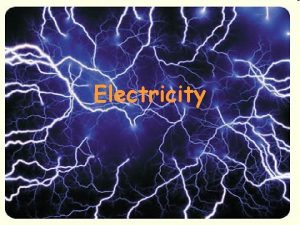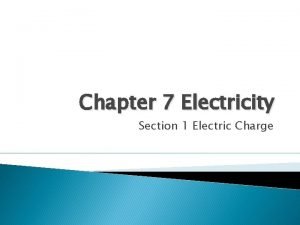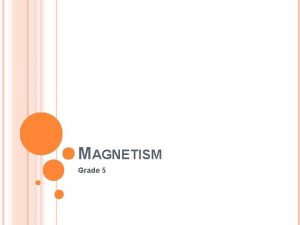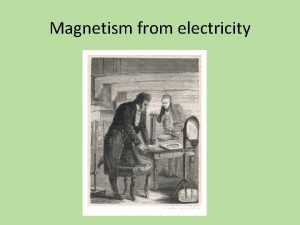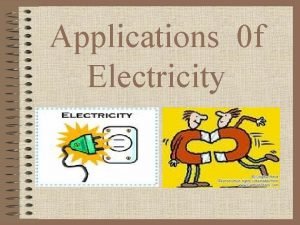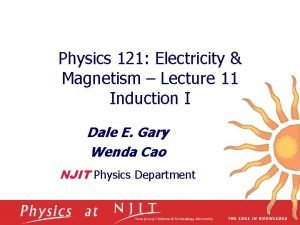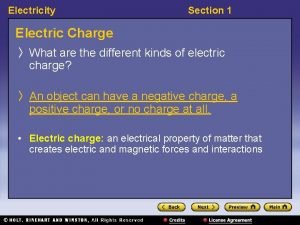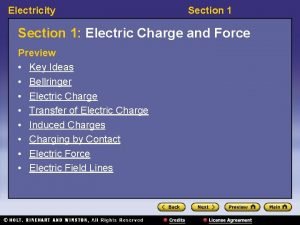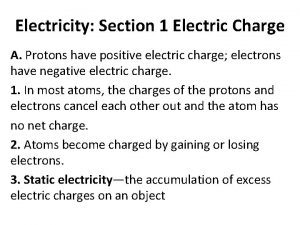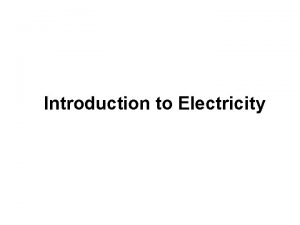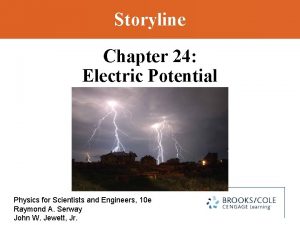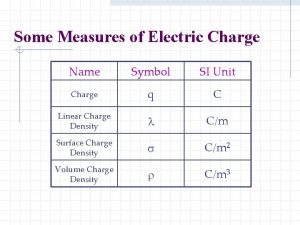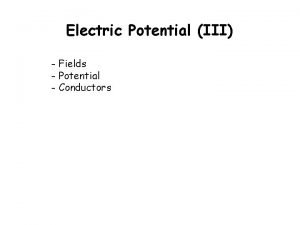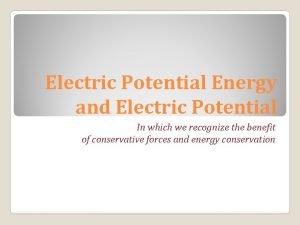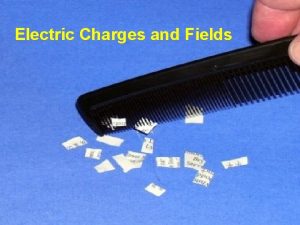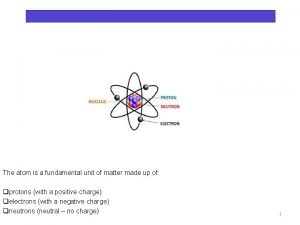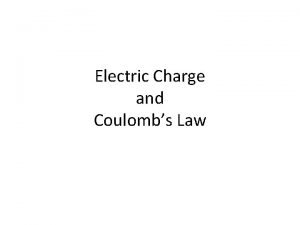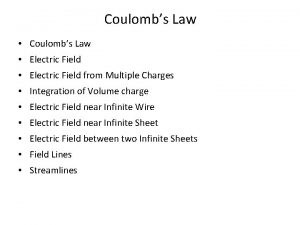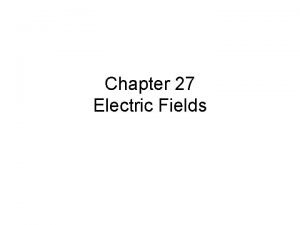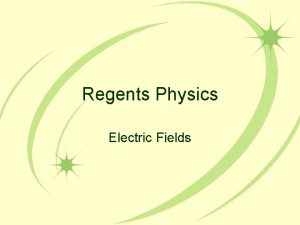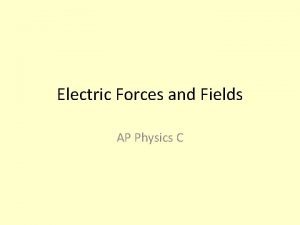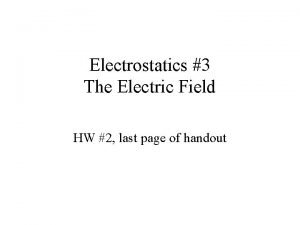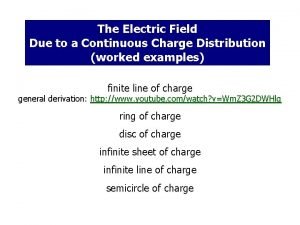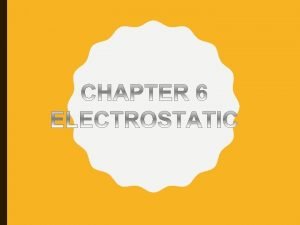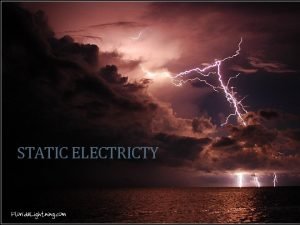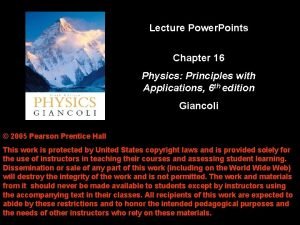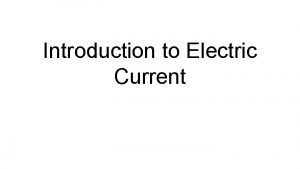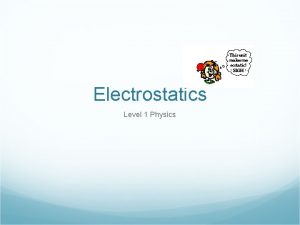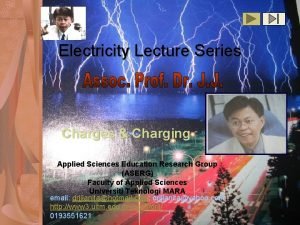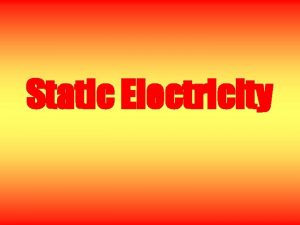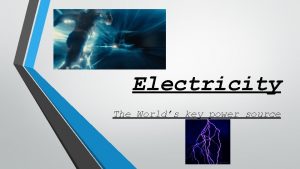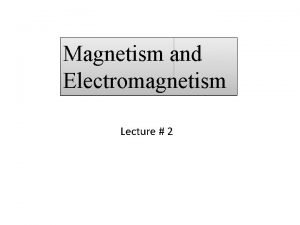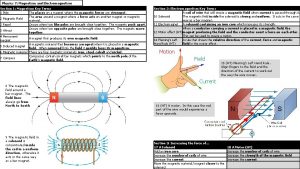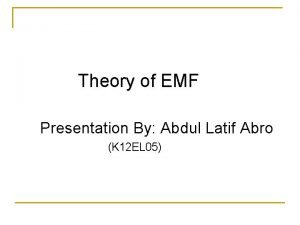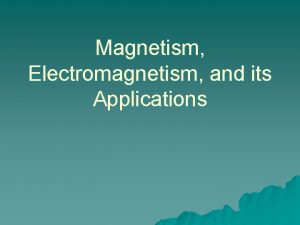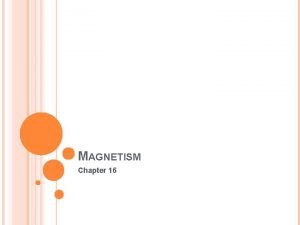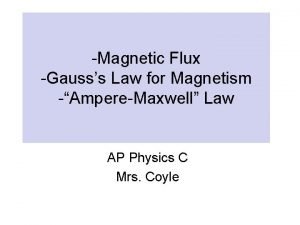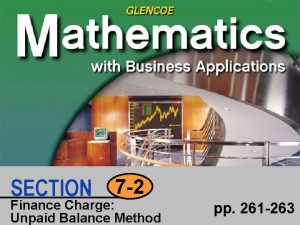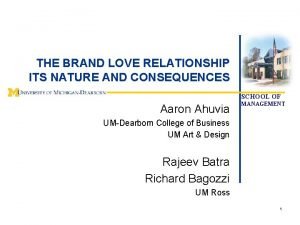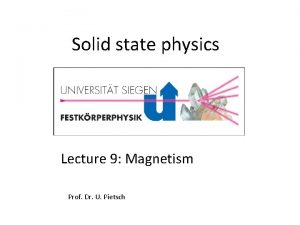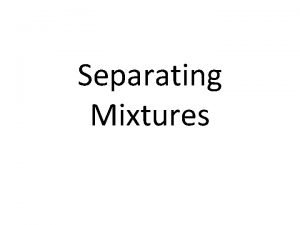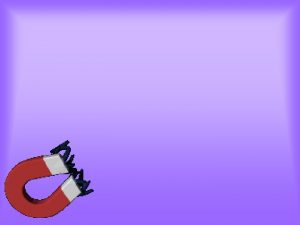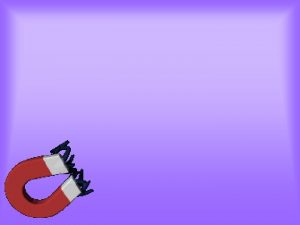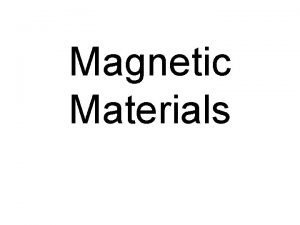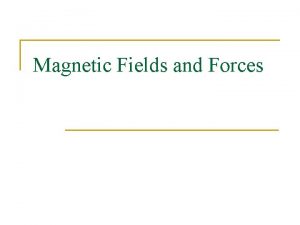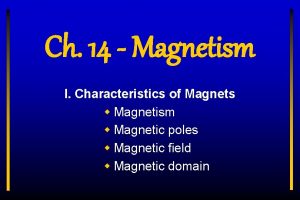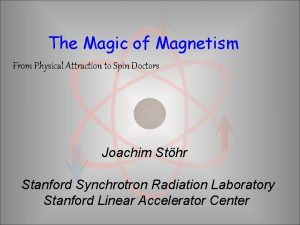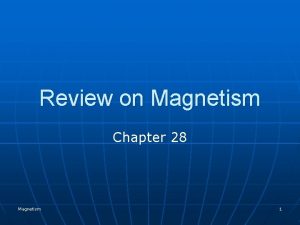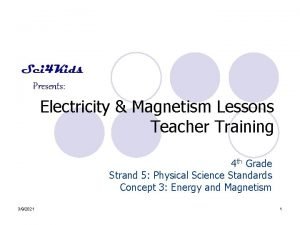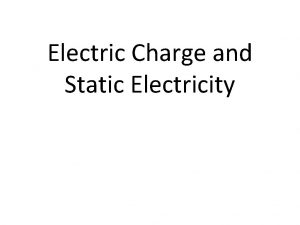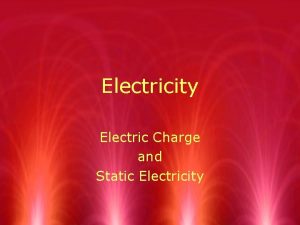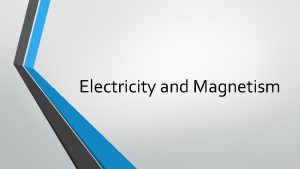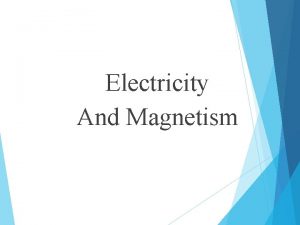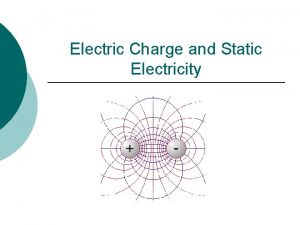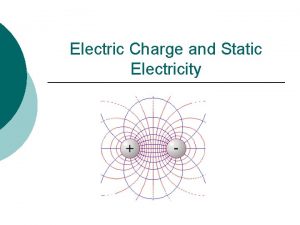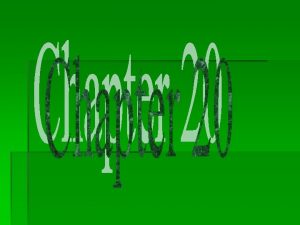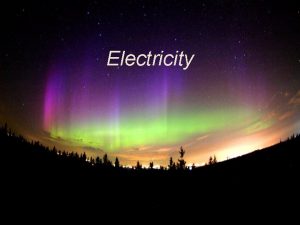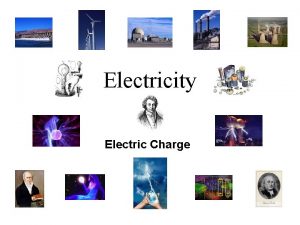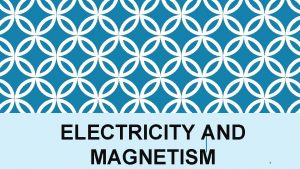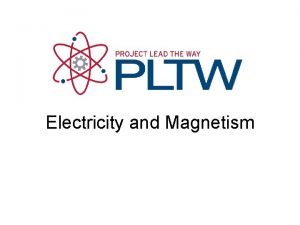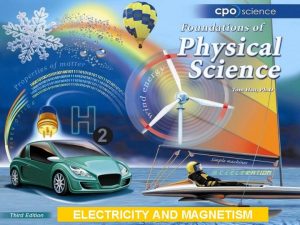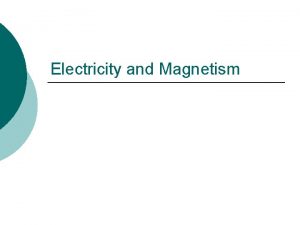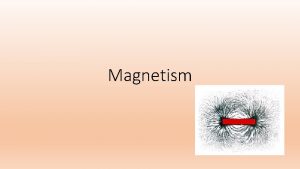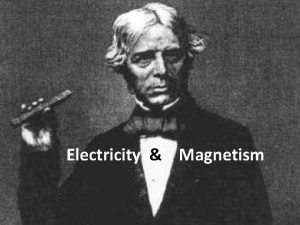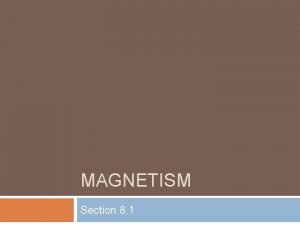Electricity and Magnetism Electricity Section 1 Electric Charge






















































































- Slides: 86

Electricity and Magnetism Electricity

Section 1 – Electric Charge and Static Electricity • Balloon and can activity • Balloon confetti

Recall: What are the parts of the atom and their charges? • 1. Proton Positive charge • 2. Neutron Neutral – No charge • 3. Electron Negative charge

How are protons, neutrons, and electrons arranged in an atom?


What happens when: 2 protons come close together 2 electrons come close together A proton and an electron come close together They repel! They Repel They attract!

So. . . • Charges that are the same repel each other and charges that are different attract each

• In what other situation do opposites attract?

• Magnetism = magnetic poles interact. (north and south) Opposites attract and like poles repel • Electricity = opposite charges attract and like charge repel

Magnetism vs. Electricity • Magnetism – Poles can’t exist on their own…. Always N and S together • Electricity – Positive charges can exist without negatives

ELECTRIC FORCE • = the attraction or repulsion between electric charges • Electric charges can exert their force over a distance. The region where that force is is called an “electric field”. – …. what does this remind you of?

Electric Fields • You can represent them using electric field lines Try to draw the field for 2 positive charges next to each other and for a positive and a negative charge.


Review: • Electrons carry a negative charge while protons carry positive charge. • The objects around us contain billions and billions of atoms, and each atom contains many protons and electrons. • The protons are located in the center of the atom, concentrated in a small area called the nucleus. • The electrons are in motion outside of the nucleus in orbitals. • The protons are basically trapped inside the nucleus and can't escape the nucleus. As a result, it is moving electrons that are primarily responsible for electricity.


Static Discharge • Most atoms have an even number of protons (+ charges) and electrons (- charges). What is the overall charge of this and most atoms? ? NEUTRAL

• In some materials (especially metals), electrons are held pretty loosely. They can move to other atoms.

What would happen if an atom LOST an electron?

What would happen if an atom GAINED an electron?

Can you see Electric charge? • What kind of instrument detects charge? • (page 40)

Static Discharge • Charges that build up in static electricity don’t stay like that forever. • Atoms and objects prefer to be neutral • When a negatively charged object and a positively charged object are brought together, electrons transfer until both objects have the same charge. • Static Discharge = loss of static electricity as electric charges transfer from one object to another

Electricity • The most commonly- observed form of electricity is probably lightning. Lightning is a big spark that occurs when lots of electrons move from one place to another very quickly. • There are three basic forms of lightning, cloud to cloud, cloud to surface, and surface to cloud. All are created when there is an unequal distribution of electrons.

Section 2 Electric Current

• Lightning is a quick release of a huge amount of electrical energy. • Unfortunately, it cannot be used to power a TV or appliances because it only lasts for a second. • Instead…. . devices need continuously flowing electric charges

• Is static electricity continuous? Do the electric charges flow continuously? NO…. The charges build up for a while and do not go anywhere. Then, in static discharge, they travel really fast and it lasts only for an instant.

What is it called when electric charges flow continuously through a material such as a wire? • An ELECTRIC CURRENT!

The RATE of the electric current • Is the amount of charge that passes through the wire in a unit of time • The UNIT for rate of a current is called…. The AMPERE ……also known as the AMP. It is the charges flowing past a given point each second. FUN FACT: It’s named after Marie Ampere… a scientist who studied electricity. See page 44 -45

• An electric current (continuously flowing electric charges) need a specific PATH to follow. The name for this PATH that the charges travel on is an ELECTRIC CIRCUIT. Compare to : cars on a race track. If part of the track is missing…. What are the cars going to do? What types of electrical devices have electric circuits?

DO NOW • Brainstorm types of materials that are often used in cooking. • Think of types of materials that are used for protection in cooking so that you do not burn yourself. • Based on the definition of electricity, why do you think some materials are good at conducting electricity and others are not?

• Wires are usual made of metal. Would a circuit with wires made from plastic or string have the same effect? – No…. . Different materials have different properties.

• A Conductor transfers electric charge well. • An insulator does not transfer electric charge well

CONDUCTORS • Ex: metals – silver/copper/aluminum/iron • Charges flow easily through these materials. • The electrons of the atoms are held loosely so they move throughout the material easily! • Electrons flow and carry an electric current and electric charge.

Turn on the lights! • Did you ever wonder why a light goes on the instant you flip the switch? How do the electrons get to your lamp from the electric company so fast? The answer is that the electrons are not sent to your house……they are already present inside the conductors of the circuit. When you flip the switch, electrons at one end of the wire are pulled while those at the other end are pushed.

INSULATORS • Ex: rubber/glass/sand/plastic/wood • Charges (electrons ) cannot flow easily because they are bound tightly to their atoms.

• So, why don’t you get a shock when you touch an extension cord that is carrying a current?

Contrary to popular belief: • Metals are NOT the only conductors! – Ex: fluorescent light bulbs have a gas that conducts electricity – Ex: some liquids and pastes in batteries conduct electricity

Classwork/ Homework • • • What is potential energy? What’s an example of a place with high potential energy? What’s an example of a place with low potential energy? What allows a roller coaster to speed down a hill? How is an electric circuit similar to a roller coaster? What provides the potential energy, and what is potential energy related to? What is the voltage of a circuit and what is another name for it? What does voltage cause? What is another way of thinking about voltage? What is a voltage source? Why is it necessary? What are examples of voltage sources? How does a voltage source get charges to move?

Potential Energy • Energy an object has as a result of its position, or height. • High potential energy top of hill • Low potential energy bottom of hill

Why does a roller coaster speed down a hill? • The difference in potential energy! …It moves from high to low

An electric circuit is similar to a roller coaster: • Circuit: : roller coaster’s steel track • Energy source(battery): : roller coaster’s motor

Electric circuit is different than a roller coaster: • Electric circuit’s potential energy is a result of charges in the battery. • BUT • A roller coaster’s potential energy is a result of height differences

The voltage of a circuit : • Is the difference in electrical potential energy between two places in a circuit. • AKA “potential difference”

What does voltage cause? • It causes a current in an electric circuit

Another way of thinking about voltage It’s the amount of FORCE pushing an electric current

A voltage source • It’s a device that creates a potential difference in an electric circuit – It has 2 terminals, so that charges will move – Ex: generator, battery

RESISTANCE • Not only does height difference or “voltage” affect the speed of a roller coaster, but the quality of wheels does too. If they are rusty, the roller coaster cannot travel as easily

Resistance, cont’d • Just like it is hard for rusty wheels to move, some materials make it hard for charges to move through them in a current. You can measure this as RESISTANCE. • The Greater the resistance, the Less current there is for a given voltage

Resistance • Gregory Ohm studied resistance. • The unit to measure resistance is the ohm!

CLASSWORK • 1. What are the 4 factors that determine resistance of a wire (or any object)? – Explain how each affects the resistance of a current • 2. What is the “path of least resistance” and how does it relate to currents? • 3. Why is it safe for a bird to sit on an uninsulated electric fence?

4 factors that determine resistance • 1. material of wire – Some hold electrons tightly (insulators)(high resistance) and others do not (low resistance) • 2. Length – The longer the wire, the more the resistance • 3. Diameter – The thinner the wire, the more the resistance • 4. temperature of wire – The lower the temperature, the lower the resistance

The PATH OF least resistance • If a current has a choice of two paths, it will choose the path of least resistance

BATTERIES • Energy can be TRANSFORMED from one form to another. • Batteries transform ____ energy to ____energy. Chemical to electrical

What is chemical energy? • It is energy stored in chemical compounds.

LUIGI GALVANI • He was an Italian physician that studied the anatomy (body structure) of frogs. • He had a brass hook that he used to hold the frogs leg muscled in place. • Then, he accidentally touched on end of the hook to an iron railing, and the frog’s leg twitched. • He had no idea what just happened and he though maybe there was a sort of “animal electricity”

Alessandro Volta • He learned about Galvani’s observations, but he made a new hypothesis. • He thought there was a chemical reaction causing the frog’s muscle to twitch • What is a chemical reaction? ? It is a process in which substances charge into new substances with different properties. “Maybe, a chemical reaction occurred between the 2 metals (the iron and the brass) and also the salty fluids in the frog’s leg muscle!”

Alessandro wanted to test it out • He placed a piece of paper soaked with salt water between a piece of zinc and a piece of silver. • Then he put wires on the silver and zinc. • Sure enough, a current WAS produced. • The more layers of this that he added, the greater the current he was able to produce

This was the FIRST electric battery!!! • Layers of zinc, paper soaked in salt water, and silver

Electrochemical Cells • An electrochemical cell = a device that transforms chemical energy into electrical energy • 2 metals called “electrodes” • They are immersed in a substance called an “electrolyte”. This solution conducts electric current. • What were the electrodes in Volta’s experiment? • What was the electrolyte in Volta’s experiment? Pg 56

A Simple Cell • Terminal = part of the electrode above the surface of the electrolyte • They make it possible to connect the cell to a circuit • Chemical reactions will cause one electrode to become negatively charged and the other to become positive.

IF you stack a bunch of electrochemical cells together…. . • You will get a BATTERY! • Batteries in your flashlight are actually just single cells, not “batteries”. To get total voltage of a battery, just add up the voltages of each individual battery.

Wet Cell VS Dry Cell • In a wet cell: • electrolyte is a LIQUID • In a dry cell: • electrolyte is a PASTE


SECTION 4 – ELECTRIC CIRCUIT: • Current, voltage, resistance are all related • Ohm studied these three factors to find out how they are related. • Resistance = Voltage / Current • Voltage = current x resistance • What if you doubled the voltage but left the resistance the same?

Units of measurement • Resistance is measured in : Ohms • Voltage is measured in: Volts (V) • Current is measured in: Amps (A)

Features of a Circuit • 1. it has devices that run by electrical energy – Ex: fan switches electrical to mechanical • 2. it has a source of electrical energy – EX: BATTERY, GENERATOR, ELECTRIC PLANT • 3. It is connected by conducting wires – THEY COMPLETE THE PATH SO CHANRGES CAN FLOW

Circuit Diagram

Series vs Parallel Circuit SERIES CIRCUIT PARALLEL CIRCUIT - One path Several paths to take If one light bulb burns out, all of them go If one light burns out, the other ones can out because the path now has a break in it still turn on If you add more lights, they get dimmer If you add more lights, brightness does not change An AMMETER should be connected in series to measure current A voltmeter should be connected in parallel to measure the voltage (electrical potential energy difference) ^ used in your home…. . why?


• Pg 68 Electrical Power • Devices often transform electrical energy into some other useful kind of energy…. Like mechanical energy in the case of a washing machine. • POWER = The rate at which energy is transformed from one form to another • Ex: a light bulb has power of 100 W

• Hair dryer transforms electrical energy into _________ • Amplifier transforms electrical energy into • _________


Power • Measured in WATTS • Power = voltage x current – UNITS: – Watts = volts x amperes • P=Vx. I • P = VI

Imagine an appliance with 200 volts and 1. 5 amps of current. What is the power? Power = voltage x current Power = 200 volts x 1. 5 amps Power = 300 WATTS

A flashlight bulb uses two 1. 5 V batters in series to create a current of 0. 5 amps. What is the power rating of the bulb? Power = Voltage x current Power = 3 V x 0. 5 amps Power = 1. 5 WATTS

A hair dryer has a power rating of 1200 watts and uses a standard voltage of 120 volts. What is the current through the hair dryer? • • Power = voltage x current 1200 watts = 120 volts x ? ? = 1200/120 ? = 10 amperes

• Just like long-distance runners don’t measure their distance in meters…. . they measure it in KILOMETERS (1000 meters)….

Paying for Electrical Energy • Often , we use a lot of power, so it is easier to measure in KILOWATTS (a thousand watts). The total energy you use depends on the power of the appliances multiplied by the amount of time they are used. Energy = Power x time (Kilowatt-hours = kilowatts x hours)

Energy = Power x time • So… if you have a 1 kilowatt appliance , and you use it for an hour…. . How much energy did you use? Energy = 1 kw x 1 hour = 1 kw-hr

ELECTRICAL SAFETY

3 main potential dangers • 1. short circuits • 2. electric shocks • 3. ungrounded wires

What is a short circuit? • If you TOUCH a downed wire: – The current wants to take the path of least resistance… so it might flow through a person rather than through the wire to the power plant. – OUCH.

ELECTRIC SHOCKS……. • Your heart, muscles, and breathing all function by electric signals… • An electric shock from a high-voltage wire could burn you or stop your heart

Grounding • If charges can flow directly from the circuit into earth in the event of a short circuit, it is GROUNDED. – 3 rd prong protects people from electric shock by connecting metal shell of an appliance to earth through a grounding wire.

Circuits might overheat…… • Therefore, we add devices called fuses and circuit breakers to circuits – FUSE = device w/ thin strip of metal that will melt if there’s too much current through it – Circuit Breaker = reusable safety switch that breaks the circuit when the current gets too high


Analyzing Data – page 72 • What does the graph show? • What determines the size of each wedge in the graph? • What percentage of fires are caused by appliances? • Which category is most responsible for fewest fires? Most fires?
 Chapter 6 section 1 electric charge worksheet answers
Chapter 6 section 1 electric charge worksheet answers Electricity section 1 electric charge
Electricity section 1 electric charge Electricity section 1 electric charge
Electricity section 1 electric charge Difference between charge and electric charge
Difference between charge and electric charge Difference between charge and electric charge
Difference between charge and electric charge Chapter 21 electric charge and electric field
Chapter 21 electric charge and electric field Chapter 21 electric charge and electric field
Chapter 21 electric charge and electric field Units for coulombs
Units for coulombs Dc o/d per item charge
Dc o/d per item charge Physics 102
Physics 102 Topic 5 ib physics
Topic 5 ib physics Magnetism
Magnetism Electricity and magnetism jeopardy
Electricity and magnetism jeopardy Sph3u electricity and magnetism
Sph3u electricity and magnetism Electromagnet experiment hypothesis
Electromagnet experiment hypothesis Magnetism and electricity
Magnetism and electricity Electricity and magnetism grade 5
Electricity and magnetism grade 5 Electricity and magnetism
Electricity and magnetism Electric fuse and circuit breaker graphic organizer
Electric fuse and circuit breaker graphic organizer Ampere
Ampere Electricity and magnetism
Electricity and magnetism Electricity and magnetism
Electricity and magnetism Electricity and magnetism vocabulary
Electricity and magnetism vocabulary Chapter 17 section 1 electric charge and force answer key
Chapter 17 section 1 electric charge and force answer key Section 1 electric charge crossword puzzle answers
Section 1 electric charge crossword puzzle answers Section 1 electric charge
Section 1 electric charge Protons electric charge
Protons electric charge Static electricity and current electricity
Static electricity and current electricity Current electricity gif
Current electricity gif Symbol for coulomb
Symbol for coulomb Potential energy formula
Potential energy formula Electric field electric potential
Electric field electric potential Potential energy due to point charges
Potential energy due to point charges Electric charges and electric forces lesson outline
Electric charges and electric forces lesson outline Electric field of a finite line charge
Electric field of a finite line charge Symbol for surface charge density
Symbol for surface charge density What is electric charge measured in
What is electric charge measured in Electrostatics equations
Electrostatics equations Electric field of a finite line charge
Electric field of a finite line charge Electrostatic potential energy
Electrostatic potential energy Amber electrostatic
Amber electrostatic Charge on proton
Charge on proton Charge unit
Charge unit Electric field of infinite line
Electric field of infinite line Electric field equations
Electric field equations Sheet of charge electric field
Sheet of charge electric field Electric field lines about a point charge extend
Electric field lines about a point charge extend Electric field of line charge
Electric field of line charge Force on charge in electric field
Force on charge in electric field Electric field due to a continuous charge distribution
Electric field due to a continuous charge distribution Electric charge
Electric charge What is electric charge
What is electric charge Units of charge
Units of charge Continuous flow of electric charges
Continuous flow of electric charges Induction charging physics
Induction charging physics Charging by contact
Charging by contact Electric charges
Electric charges Electric charge
Electric charge Stationary electric charge
Stationary electric charge Unidirectional flow of electric charge
Unidirectional flow of electric charge Electric potential vs electric potential energy
Electric potential vs electric potential energy A suitable electric pump in an electric circuit is a
A suitable electric pump in an electric circuit is a Magnetic lines of force
Magnetic lines of force Magnetism and electromagnetism
Magnetism and electromagnetism Electric bell bbc bitesize
Electric bell bbc bitesize Abro orientation
Abro orientation Magnetism and electromagnetism
Magnetism and electromagnetism What is magnet and magnetism
What is magnet and magnetism Magnetism and gauss law
Magnetism and gauss law Unpaid balance method formula
Unpaid balance method formula Section 7-2 finance charge answers
Section 7-2 finance charge answers Magnetism love
Magnetism love Magnetism
Magnetism What is magnetism in separating mixtures
What is magnetism in separating mixtures Aportaciones de hans christian oersted
Aportaciones de hans christian oersted It is an invisible force
It is an invisible force Magnetism is an invisible
Magnetism is an invisible Electromagnetic particle inspection
Electromagnetic particle inspection Hysteresis loop
Hysteresis loop Magnetic force formula
Magnetic force formula Displacement current and maxwell's equations
Displacement current and maxwell's equations Magnetism test review
Magnetism test review Chapter 24 magnetism magnetic fundamentals answers
Chapter 24 magnetism magnetic fundamentals answers Characteristics of magnets
Characteristics of magnets Joachim stöhr
Joachim stöhr Magnetism
Magnetism Basics of magnetism
Basics of magnetism

